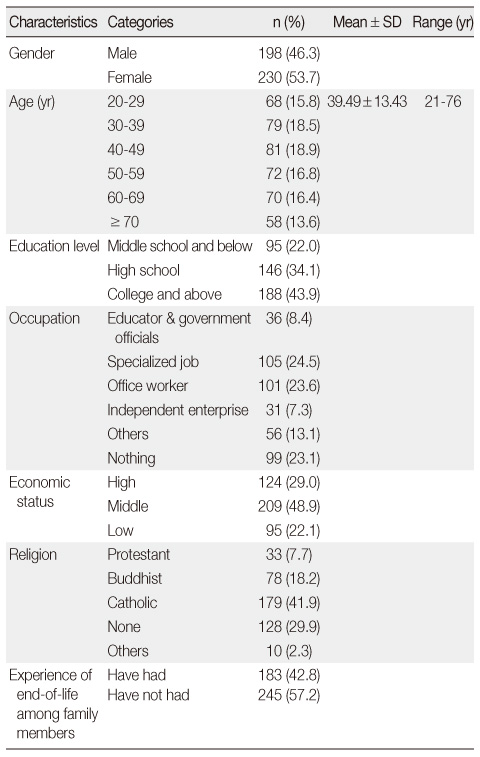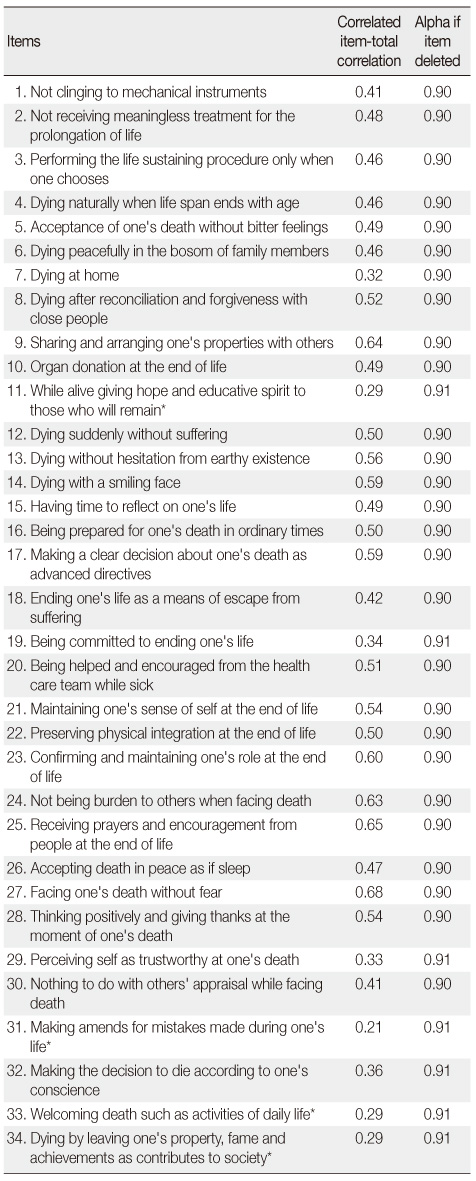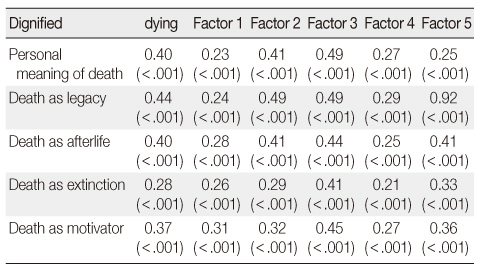Articles
- Page Path
- HOME > J Korean Acad Nurs > Volume 41(3); 2011 > Article
-
Original Article
- Development and Evaluation of a Dignified Dying Scale for Korean Adults
- Kae-Hwa Jo
-
Journal of Korean Academy of Nursing 2011;41(3):313-324.
DOI: https://doi.org/10.4040/jkan.2011.41.3.313
Published online: June 13, 2011
Professor, College of Nursing, Catholic University of Daegu, Daegu, Korea.
- Address reprint requests to: Jo, Kae-Hwa. College of Nursing, Catholic University of Daegu, 3056-6 Daemyeong 4-dong, Nam-gu, Daegu 705-718, Korea. Tel: +82-53-650-4825, Fax: +82-53-621-4106, jokw@cu.ac.kr
• Received: August 20, 2010 • Accepted: June 7, 2011
© 2011 Korean Society of Nursing Science
Abstract
-
Purpose
- The study was done to develop a dignified dying scale for Korean adults.
-
Methods
- The process included construction of a conceptual framework, generation of initial items, verification of content validity, selection of secondary items, preliminary study, and extraction of final items. The participants were 428 adults who lived in one of 3 Korean metropolitan cities: Seoul, Daegu, and Busan. Item analysis, factor analysis, criterion related validity, and internal consistency were used to analyze the data. Data collection was done from March to June 2010.
-
Results
- Thirty items were selected for the final scale, and categorized into 5 factors explaining 54.5% of the total variance. The factors were labeled as maintaining emotional comfort (10 items), arranging social relationship (9 items), avoiding suffering (3 items), maintaining autonomous decision making (4 items), and role preservation (4 items). The scores for the scale were significantly correlated with personal meanings of death scale. Cronbach's alpha coefficient for the 30 items was .92.
-
Conclusion
- The above findings indicate that the dignified dying scale has a good validity and reliability when used with Korean adults.
This research was supported by Basic Science Research Program through the National Research Foundation of Korea (NRF) funded by the Ministry of Education, Science and Technology (2010-0007170).
- 1. Abdel-Khalek AM. Why do we fear death? The construction and validation of the reasons for death fear scale. Death Studies. 2002;26:669–680. doi:10.1080/07481180290088365.ArticlePubMed
- 2. Anderberg P, Lepp M, Berglund AL, Segesten K. Preserving dignity in caring for older adults: A concept analysis. Journal of Advanced Nursing. 2007;59:635–643. doi:10.1111/j.1365-2648.2007.04375.x.ArticlePubMed
- 3. Chochinov HM. Dying, dignity, and new horizons in palliative end-of-life care. CA: A Cancer Journal for Clinicians. 2006;56:84–103. doi:10.3322/canjclin.56.2.84.ArticlePubMed
- 4. Cicirelli VG. Personal meanings of death in relation to fear of death. Death Studies. 1998;22:713–733. doi:10.1080/074811898201236.ArticlePubMed
- 5. Collett LJ, Lester D. The fear of death and dying. Journal of Psychology. 1969;72:179–181.PubMed
- 6. Corless IB, Nicholas PK, Nokes KM. Issues in cross-cultural quality of life research. Journal of Nursing Scholarship. 2001;33:15–20. doi:10.1111/j.1547-5069.2001.00015.x.ArticlePubMed
- 7. Curtis JR, Patrick DL, Engelberg RA, Norris K, Asp C, Byock I. A measure of the quality of dying and death: Initial validation using after-death interviews with family members. Journal of Pain and Symptom Management. 2002;24:17–31. doi:10.1016/S0885-3924(02)00419-0.ArticlePubMed
- 8. Doorenbos AZ, Wilson SA, Coenen A, Borse NN. Dignifi-ed dying: A phenomenon and actions among nurses in India. International Nursing Review. 2006;53:28–33. doi:10.1111/j.1466-7657.2006.00458.x.ArticlePubMed
- 9. Gauthier DM, Froman RD. Preference for care near the end of life: scale development and validation. Research in Nursing and Health. 2001;24:298–306. doi:10.1002/nur.1031.PubMed
- 10. Greyson B. Cardena E, Lynn SJ. Near-death experiences. In: Varieties of anomalous experience: Examining the scientific evidence. 2001;Washington, DC, American Psychological Association. 315–352.
- 11. Harville M, Stokes SJ, Templer DI, Rienzi B. Relation of existential and religious variables to the death depression scale-revised. Omega. 2004;48:165–184.ArticlePDF
- 12. Holcomb LE, Neimeyer RA, Moore MK. Personal meanings of death: A content analysis of free response narratives. Death Studies. 1993;17:299–318. doi:10.1080/07481189308252627.Article
- 13. Jacelon CS, Connelly TW, Brown R, Proulx K, Vo T. A concept analysis of dignity for older adults. Journal of Advanced Nursing. 2004;48:76–83. doi:10.1111/j.1365-2648.2004.03170.x.ArticlePubMed
- 14. Jacobson N. Dignity and health: A review. Social Science and Medicine. 2007;64:292–302. doi:10.1016/j.socscimed.2006.08.039.ArticlePubMed
- 15. Jo KH. The meaning of dignified dying perceived by nursing students. Journal of Korean Academic Society of Nursing Education. 2010;16:72–82.Article
- 16. Jo KH, Lee HJ, Lee YJ. Types of students' death attitudes majoring in human service area: Q methodological approach. Journal of Korean Academy of Nursing. 2005;35:829–841.ArticlePubMedPDF
- 17. Kei HY. Constitutional law. 2005;Seoul, Pakyoungsa.
- 18. Kim CS. Constitutional law. 2008;18th ed. Seoul, Pakyoungsa.
- 19. Kwon BG, Kim HC. Bioethics & law. 2009;Seoul, Ewha Womans University Press.
- 20. Kwon YS. Constitutional law. 2008;Paju, Bobmunsa.
- 21. Lee EO, Im RY, Park HA, Lee IS, Kim JI, Bae JI, Lee SM. Nursing Research and Statistical Analysis. 2009;Seoul, Soomoonsa.
- 22. Lee HK, Jo KH. A pathmodel for death anxiety to suicidal ideation of the elderly. Journal of the Korean Gerontological Society. 2006;26:717–731.
- 23. Lee HS. Korean dictionary. 2008;Paju, Minjungsearim.
- 24. Lee YJ, Kim SM. Validating the Korean version of the preferences for care near the end-of-life (PCEOL-K) scale. Korean Journal of Medical Ethics. 2009;12:29–42.ArticlePDF
- 25. Leung D. Granting death with dignity: Patient, family and professional perspectives. International Journal of Palliative Nursing. 2007;13:170–174.PubMed
- 26. Lynn MR. Determination and quantification of content validity. Nursing Research. 1986;35:382–385.PubMed
- 27. Proulx K, Jacelon C. Dying with dignity: The good patient versus the good death. American Journal of Hospice and Palliative Care. 2004;21:116–120. doi:10.1177/104990910402100209.ArticlePubMedPDF
- 28. Pullman D. Death, dignity and moral nonsense. Journal of Palliative Care. 2004;20:171–178.ArticlePubMedPDF
- 29. Ryu CS. SPSS 14.0 for Windows. 2006;5th ed. Seoul, Elite.
- 30. Skevington SM, Bradshaw J, Saxena S. Selecting national items for the WHOQOL: Conceptual and psychometric considerations. Social Science and Medicine. 1999;48:473–487. doi:10.1016/S0277-9536(98)00355-4.ArticlePubMed
REFERENCES
Figure & Data
REFERENCES
Citations
Citations to this article as recorded by 

- Factors That Influence Attitudes toward Advance Directives among Female Cancer Patients
Aeri Kim, Kisook Kim
The Korean Journal of Hospice and Palliative Care.2023; 26(2): 80. CrossRef - Development and Validation of a Dignity in Care Scale of Terminally Ill Patients for Nurses
Yun Sil Ahn, Pok Ja Oh
Journal of Korean Academy of Nursing.2023; 53(3): 340. CrossRef - Factors Influencing Advanced Directives Among Hemodialysis Patients
Eunseong SON, Minjeong SEO
Korean Journal of Medical Ethics.2022; 25(3): 243. CrossRef - The Relationships Between Oncology Nurses’ Attitudes Toward a Dignified Death, Compassion Competence, Resilience, and Occupational Stress in South Korea
Sun-A Park, Hee Jung Park
Seminars in Oncology Nursing.2021; 37(3): 151147. CrossRef - Factors Affecting Intention of Signing an Advanced Directives in Cancer Patients
Eun-Ju Ha, Mee Ock Gu
Journal of Korean Academy of Fundamentals of Nursing.2021; 28(1): 121. CrossRef - The Effect of Hospice Patients' Pain, Anxiety, Depression, Perception of Dignity, and Spiritual Well-Being on their Attitudes toward Dignified Death
Yun Sil Ahn, Pok Ja Oh
Korean Journal of Adult Nursing.2021; 33(3): 212. CrossRef - Factors affecting Elders' Acceptance of Death
Seon Mi Ha, Jung Seop Lee
Journal of Korean Gerontological Nursing.2017; 19(3): 165. CrossRef - Types of Attitudes of Nursing Students in Korea Toward Bucket Lists Q-Methodological Approach
Hong Seon Lee, Kae Hwa Jo, Hyun Ji Lee
The Journal of Korean Academic Society of Nursing Education.2015; 21(1): 129. CrossRef - Health Care Professional Factors Influencing Shared Medical Decision Making in Korea
Kae-Hwa Jo, Gyeong-Ju An, Hong Seon Lee
Sage Open.2015;[Epub] CrossRef - Feasibility Evaluation of Korean Advance Directives (K-AD)
Shin Mi Kim, Sun Woo Hong, Jin Shil Kim, Ki Sook Kim
The Journal of Korean Academic Society of Nursing Education.2014; 20(4): 639. CrossRef - Preferences for Care Near the End of Life among Hospital Employees
Jiyeon Kang, Seonyoung Yun, Soo Jeong Kim, So Ra An, Myeong Hee Lee, Shinmi Kim
Journal of muscle and joint health.2013; 20(3): 197. CrossRef - The Impact of Nurses’ Attitude toward Dignified Death and Moral Sensitivity on Their End-of-Life Care Performance
Kae Hwa Jo, Yeon Ja Kim
The Korean Journal of Hospice and Palliative Care.2013; 16(4): 223. CrossRef - Predictive Factor s for City Dweller s’ Attitudes toward Death with Dignity
Kae Hwa Jo, Gyeong Ju An, Gyun Moo Kim, Yeon Ja Kim
The Korean Journal of Hospice and Palliative Care.2012; 15(4): 193. CrossRef - Development and Evaluation of Shared Medical Decision-Making Scale for End-of-Life Patients in Korea
Kae Hwa Jo
Journal of Korean Academy of Nursing.2012; 42(4): 453. CrossRef
- Figure
- We recommend
- Related articles
-
- Development and Psychometric Evaluation of the Ischemic Stroke Distress Scale (ISDS)
- Development and Evaluation of Evidence-Based Nursing Protocol for Extracorporeal Membrane Oxygenation to Critically Ill Patients
- Development and Validation of a Dignity in Care Scale of Terminally Ill Patients for Nurses
- Development of a Reward Scale for Hospital Nurses
Development and Evaluation of a Dignified Dying Scale for Korean Adults

Figure 1
Conceptual framework of dignified dying of Korean adults.
Figure 1
Development and Evaluation of a Dignified Dying Scale for Korean Adults
Demographic Characteristics of Participants (N=428)
Item Analysis (N=428)
*Item deleted by item analysis.
Factor Analysis and Reliability (N=428)
Correlation between Dignified Dying Scale and Personal Me-aning of Death Scale (N=428)
Table 1
Demographic Characteristics of Participants (N=428)
Table 2
Item Analysis (N=428)
*Item deleted by item analysis.
Table 3
Factor Analysis and Reliability (N=428)
Table 4
Correlation between Dignified Dying Scale and Personal Me-aning of Death Scale (N=428)
 KSNS
KSNS
 E-SUBMISSION
E-SUBMISSION





 Cite
Cite

